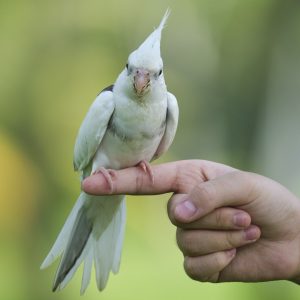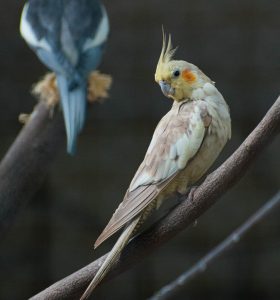Cockatiels, as delightful and enchanting parrot species, have captivated the hearts of bird enthusiasts around the world. With their charming personalities and intriguing behaviors, they quickly become cherished members of the family. An essential aspect of bonding with these feathered companions is understanding how cockatiels show affection.
Recognizing and interpreting these affectionate birds displays can significantly enhance the connection between the bird and its owner, and it contributes to a positive and nurturing environment for everyone involved. In this guide, we will explore the various ways in which cockatiels demonstrate their love and fondness, providing a deeper insight into their endearing world. So let’s dive into the delightful realm of how cockatiels show affection and strengthen the bond with these feathery friends.

How Cockatiels Show Affection?
Male cockatiels tend to more seek attention and it’s up to you as a pet owner to win your new companion’s confidence. It’s the same with forming a fresh relationship; you can’t sit there and do nothing expect him or her to comply. Cockatiel likes also put you to the test in order for them to gain your affection. Expect that your cockatiel loves; genuinely adore you until their last breath when you have earned their trust.
Your bird’s affection can be affected by how you deal with and care for them. If you look after your bird properly, your bird will do the same for you.
Noise
Cockatiels show their happiness at seeing their owners through noisy greetings, much like people do when they see friends. Forms of affection from these birds include chirping, singing and even banging toys against cage bars. Cockatiels aren’t big talkers in general, but will make noise to express excitement and love. On the other hand, a ‘tiel that is silent as you approach it is not interested in interacting with humans at that moment.

Movement
If your cockatiel is pleased to see you, he may move excitedly back and forth in his cage or jump to the front when you approach. Once let out, he’ll lower his head so you can pet him. If he isn’t feeling social at the moment, he’ll just sit on his perch as you come near.
Physical Affection
An amorous cockatiel will frequently flock to your shoulder while out of the cage to perch. Your cockatiel may bite or mess with your hair. He could attempt to groom your brows. Cockatiels nip, but physical contact should not be painful.
Cockatiel Crest
Crests of certain species can tell you what’s going on in your bird’s head. When a cockatiel’s crest is pushed against his head, he’s on guard or hostile. He also becomes alert and suspicious when his crest is fully erected, or parallel to his head. When the crest feathers hang between those two states, he’s calm and interested. Approach your pet when he’ s in the relaxing or curious mood with other indications of affection displays.
They Will Always Pick You
These pet birds are very theatrical. They display their affection for their owner. When singing, they typically remove their hood, raise their wing, and straighten up their upper body. This is done to gain complete attention from their owner. Cockatiels have numerous socializing instructions when it comes to interacting with people.
They Stick With You Like Glue
Cockatiels will court you as their owner in an attempt to show affection, characterized by raised feathers around the head and jaw area, a slightly elevated upper body, and dilated pupils. Be ready for your little feathered friend to bring lots of life into your world.
They learn to like the cage. The cheerful chirping of your birds becomes an integral part of your daily routine. They’ll do whatever you ask them to do, and they’ll follow you everywhere you go.
Loves To Play
Your cockatiel will enjoy playing with toys from time to time, therefore he or she appreciates them. If you’re buying a toy for your cockatiel buddy, be sure it’s bright because they love bright colors. Bells are one of their favorite toys. In certain situations, you may note a bird falling asleep with the bell beside it.
A piece of wood for your cockatiel to peck and chew on is essential. A ladder can also be a fantastic way to spice up their everyday routine. A ladder adds a little more spice since your feather buddy loves to climb up and down.
- Size: 8.7x3.9 inch /22x10 cm
- Made of metal, it is safe and very resistant to bite.
- Entertaining enough to keep birds busy for a long period and they do enjoy playing with it.
- The bells is sweet sound, can attract the attention of the bird.
- The toy can help pet birds to ease the unhappy moods and release the pressure to keep them stimulated and healthy mentally.
Cockatiel Bonding Signs

It might take some time for both you and your new cockatiel to warm up to each other. For other birds, this process can be especially slow since they need time to form bonds. However, if you’re patient and put in the effort, eventually you’ll have a strong bond with your pet.
You’ll know you’re bonding with your cockatiel if it starts coming close to you and doesn’t leave your side.
Do Cockatiels Recognize Their Owners?
Cockatiels can recognize their caretakers, and they are highly responsive to their caretaker’s voices. It is a species of pet bird that is simple to train. Male cockatiels and female cockatiels are also excellent choices for both children and adults since they are clever and sociable when they are already linked to you.
Cockatiels are clever. They may be taught how to perform tricks, and they adore laughing. Cockatiels are amazing birds that you can have as a pet.
Final Thoughts on How Cockatiels Show Affection
The love that a particular bird has for the bird owners is unique. The cockatiel’s body language is a sign of bonding and is a one-of-a-kind way for them to demonstrate their trust and affection toward their family member.
Cockatiels make excellent pets for children and adults alike. They are loving creatures that can bring joy to your family, and they appreciate any effort you put into taking care of them. Just be warned that they might show you a bit too much affection!
For more comprehensive insights and tips on cockatiel care and related topics, explore our additional articles. Find out if leeks are a safe treat for your bird in Can Cockatiels Eat Leeks?. Curious about kidney beans? Learn whether they are suitable for your cockatiel by reading Can Cockatiels Eat Kidney Beans?. Ensure your pet’s environment is safe by checking out Are Paint Fumes Bad for Cockatiels?. For an interesting take on health, read about the effects of sweets in Chocolate and Dental Health. Finally, understand common cockatiel behaviors with Why Does a Cockatiel Stand on One Leg?. Each of these articles is packed with valuable information to help ensure your cockatiel’s health and happiness.




